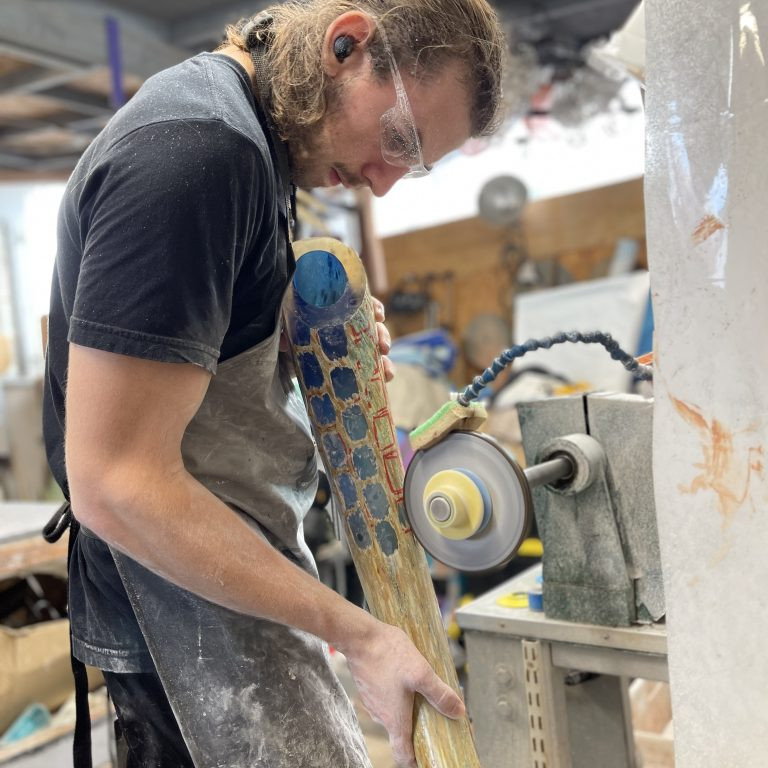Ray Besserdin Paper Sculpture Artist - Melbourne, Australia
With years of working with paper, Ray Besserdin’s paper truly becomes sculpture
Zoneone Arts brings Ray Besserdin to you…
Can you discuss and compare your love of art and fascination with insects?
That’s something that a lot of people wonder about. Both started as a child. My mother was an illustrator and cartoonist for books and newspapers and created an extensive folio of aquarelle artworks she did of Melbourne’s historic buildings, many of which are gone now. Incidentally, I’m publishing a book of her art in 2019 as she passed away when I was 15 and I have all her works. I’ll let you know when it’s released.
My father was an engineer but also a very accomplished portrait painter who for a short time in his youth even studied art and wood sculpture. Both were active members of the Victorian Artist’s Society, so I grew up with art around all around me, and I suppose I take after both in different ways. Mum was a very freehand artist and dad very technically precise. I developed both ways.
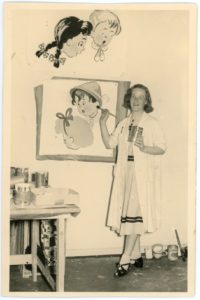
As a kid mum and dad used to buy me these books from which you could cut out and form models of cars, trains, planes and more. I absolutely loved them! Of course, they led to me figuring out how to make my own models from paper or cardboard. When I saw a blank sheet of paper, I saw opportunity to make stuff and couldn’t wait to get a pencil, scissors and sticky tape out, so I could go to work. I even make models from empty tissue boxes!
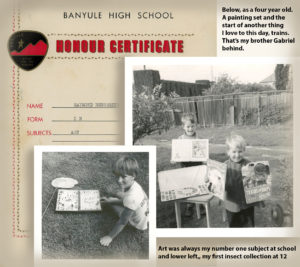
Later, I later started making pop-up greeting cards for the family, any old occasion would do, practicing both drawing and modelling n’ mechanics with paper. But interestingly, though I still have the very basic Origami book they bought me back then, and remember having some fun doing the exercises, I never really took a shine to it, as clever as I recognise Origami to be.
However, it all played its role in developing passion for paper and skills for working with it.
My father also gave me memorable encouragement to take interest in sciences. Combining my childhood curiosity for the all the insects I found exploring the vegetation in our garden, I steadily developed a hunger to learn all I could about them, and the more I learned, the more intrigued I became.
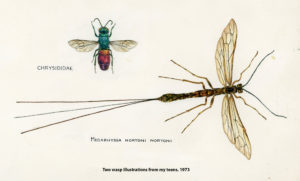
It developed into a heightened desire to pursue biological sciences at a university level and was the reason I chose to graduate in this field rather than Art. But here’s the funny thing, by the time I was completing my final undergrad year at La Trobe Uni, my assignments were becoming as much about content as opportunity to practice art! I knew by then that my science pursuits had run their natural course and that I really wanted to be an artist. But insects especially continue to intrigue me, so the obvious solution was to express my love of them in my art where the opportunity arose. I’ve done a couple in paper sculpture to set the course for a future exhibition, but I’m still a little way off it. With my current commitments and commissions out of the way, perhaps 2019 will see me get into it full swing. It really excites me! I’m also still an active council member of the Victorian Entomological Society, for whom I designed their current logo.
Regardless of insects however, nature is still the key subject to most of my art.

The Red Sands Garden
The exhibition collection I’ve called “Impressions of Melbourne’s Botanical Gardens in Paper Sculpture” is an example. Two of the planned six 915 x 915 cm pieces are now complete with the third begun. I’m aiming for that to be public about April 2019.
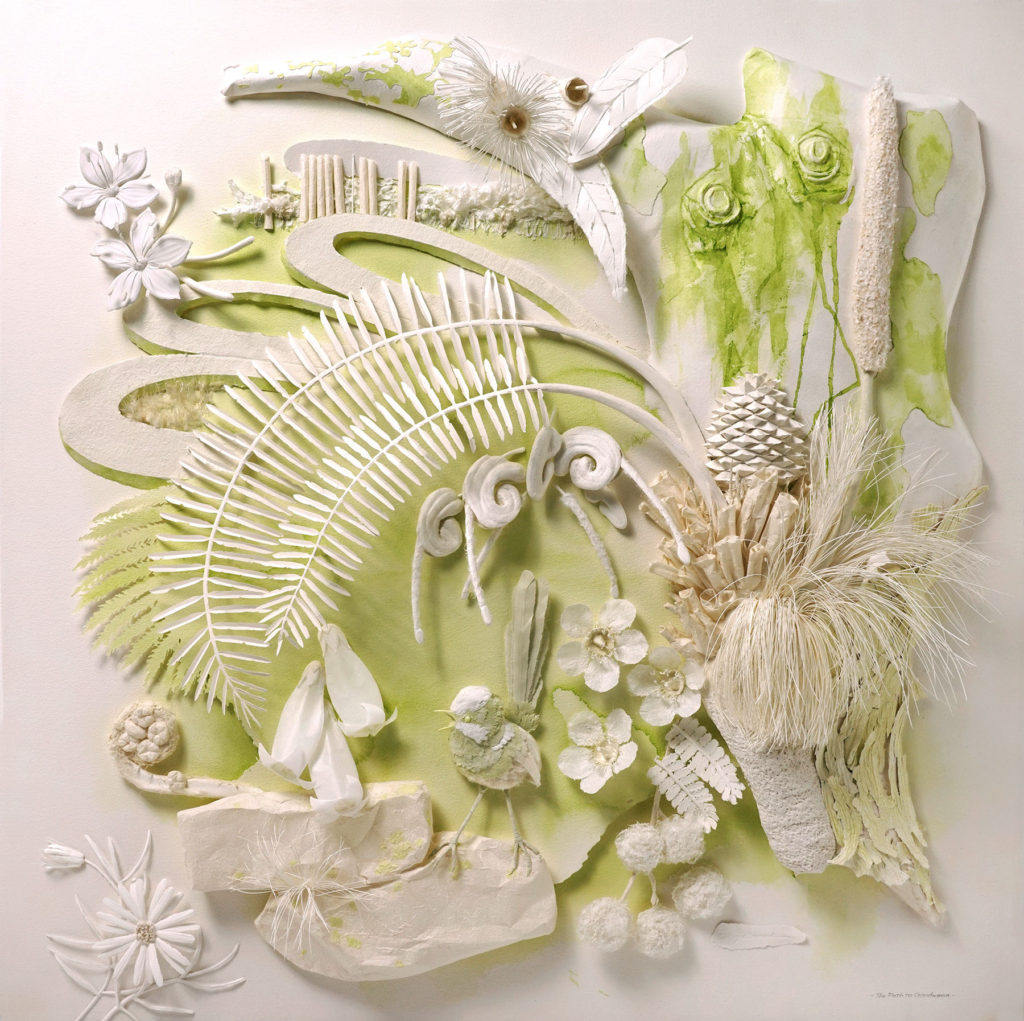
The Path to Gondwana
Awarded 1st Prize, in “Nature” Category 3D, at LightsSpaceTime, Gallery, Florida, USA
Expand on how your commercial design for Spicers Paper began your career in paper sculpture.
While I was going through Uni I picked up reasonably regular graphic design and illustration jobs for income when people discovered my art ability, so when I finished I could hit the streets with a good folio to show design studios, ad agencies and publishers. Before long, I landed a paid inhouse spot with a design business in Collins Street and then went on developing my skills in design and illustration full time. I especially practiced with a gadget called an airbrush. I could create artworks that were photo realistic and ad agencies loved it because it airbrush illustration was like today’s Photoshop in the eighties and nineties.
After six years, I left the design firm in late 1988 and went completely freelance. My first studio was a room I rented from a marketing firm in North Melbourne, and there were some good ad agencies nearby who I presented myself to. I can’t remember what they were called, but there was one that began to use me for various things on a regular basis, especially if their own art director was on holidays or otherwise too busy. One of their accounts was Spicers Paper and they were running a print campaign to enter a competition for a free trip to Chicago for the world Stationery Expo being held there. They needed a catchy logo and called me in to help design one.
 Spicers, the first paper sculpture
Spicers, the first paper sculpture
Trying to picture an image of Chicago I saw tall buildings and what stood out in my mind for all the 30s gangster movies I watched as kid. Then I had a flashback to my childhood days of making stuff out of paper, and bang(!), I could completely see what I would go back and present the agency. They loved the proposal, I went off and created the artwork, it went onto to play a key role in the campaign being the most successful they had ever run and I woke up to my future all in one! No one piece of art I had created to that point in my life inspired me so much as this. I couldn’t sleep just thinking of where I could this art, but I remember say to myself, “I’m going to push this into fine art”. And that’s where I am with it today.
From there I pushed my technique to every ad agency and publisher I could, being paid to develop the art. By chance, a couple of years later I discovered a book from America where there were artworks of various mediums, some in paper, similar to what I was doing. More interesting is that there were awards being held in New York. By the start of the new millennium, I had scored one gold, two silver and over a dozen bronze. Another gold from New York came through my work being entered by a client on my behalf. I had won major corporate clients like Macquarie Bank, Ford Motor Company, The Northern Territory Government and Amcor amongst others. Private commissions even came from Manhattan and over the Pacific in New Zealand, but Australia has been my major patron.
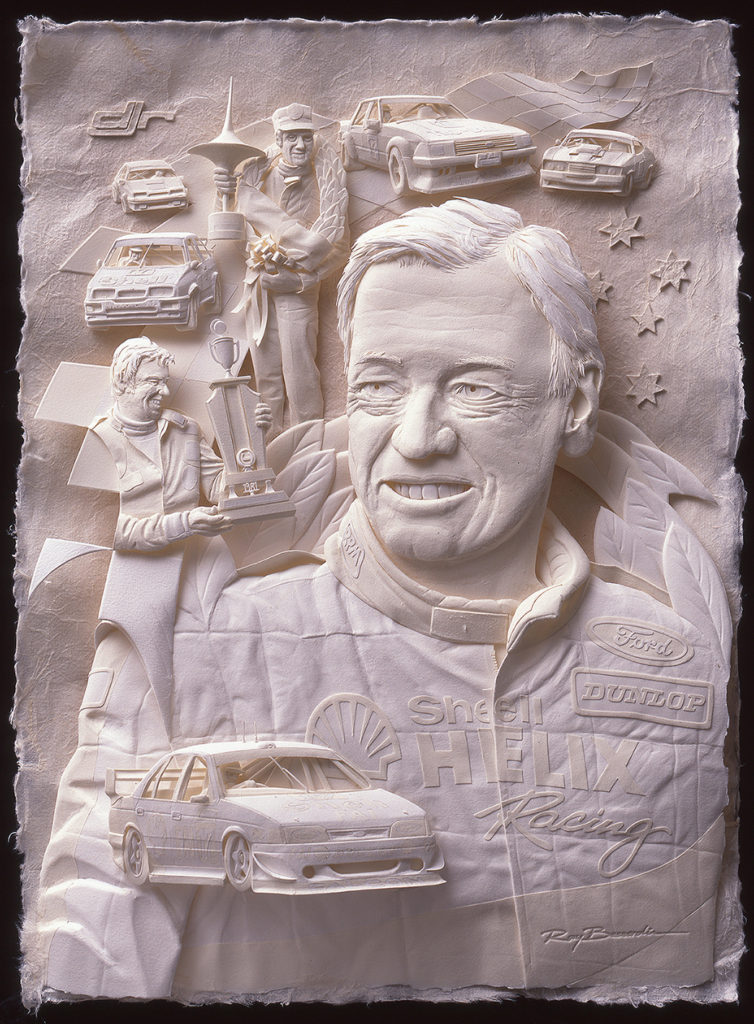
Johnston Tribute
A real knock out happened in 2000 when the NT Government came back after a number of things I created for them and asked me to come up with symbols of there iconic Saltwater Crocodile, Brolgas and Frilled Lizard all created in paper sculpture. What resulted were two 6.3m long by 3.8m high croc and lizard with 2.1m high x 3m wide dancing Brolgas in between. They were to become unofficially the world’s largest paper sculptures based on length by height. I say it that way because they were accepted for the Guinness Book of Records, but regrettably, I got so busy I missed completing the application provisions before they expired.
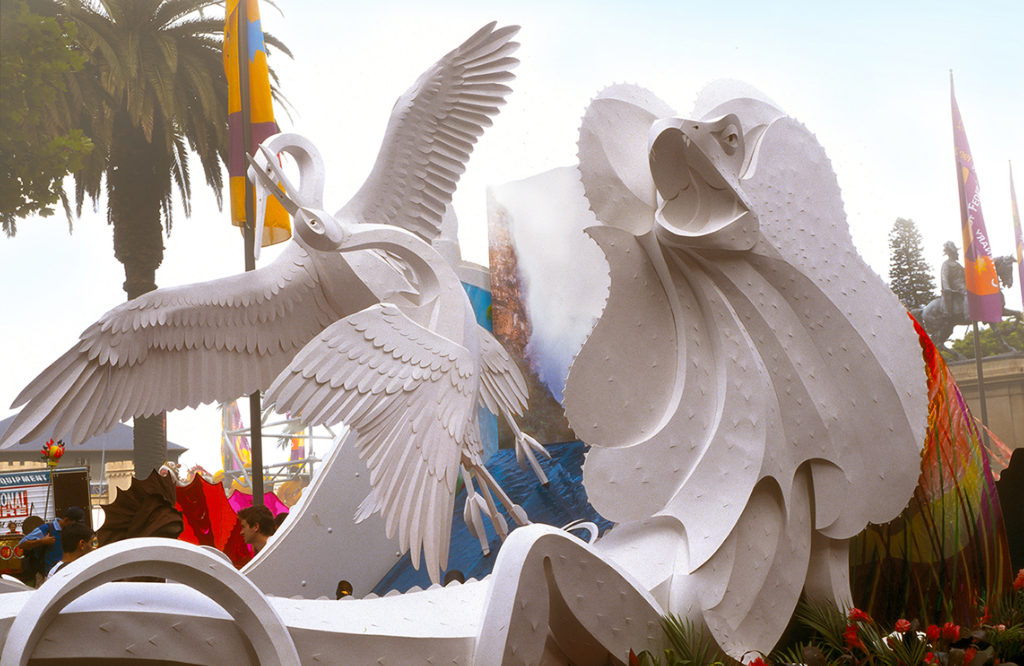 Frilled Lizard, Brolgas, Northern Territory, Australia
Frilled Lizard, Brolgas, Northern Territory, Australia
Since then I’ve continued to do commissions and win awards for advertising and publishing because they’re good sources of income besides the private and corporate commissions. The difference is they are always deadline based, but so are many of the corporate commissions.
One that stands out from 2015 is “Mother’s Heart” which I created for Queensland Investment Corporation on behalf of their Watergardens Shopping Centre.
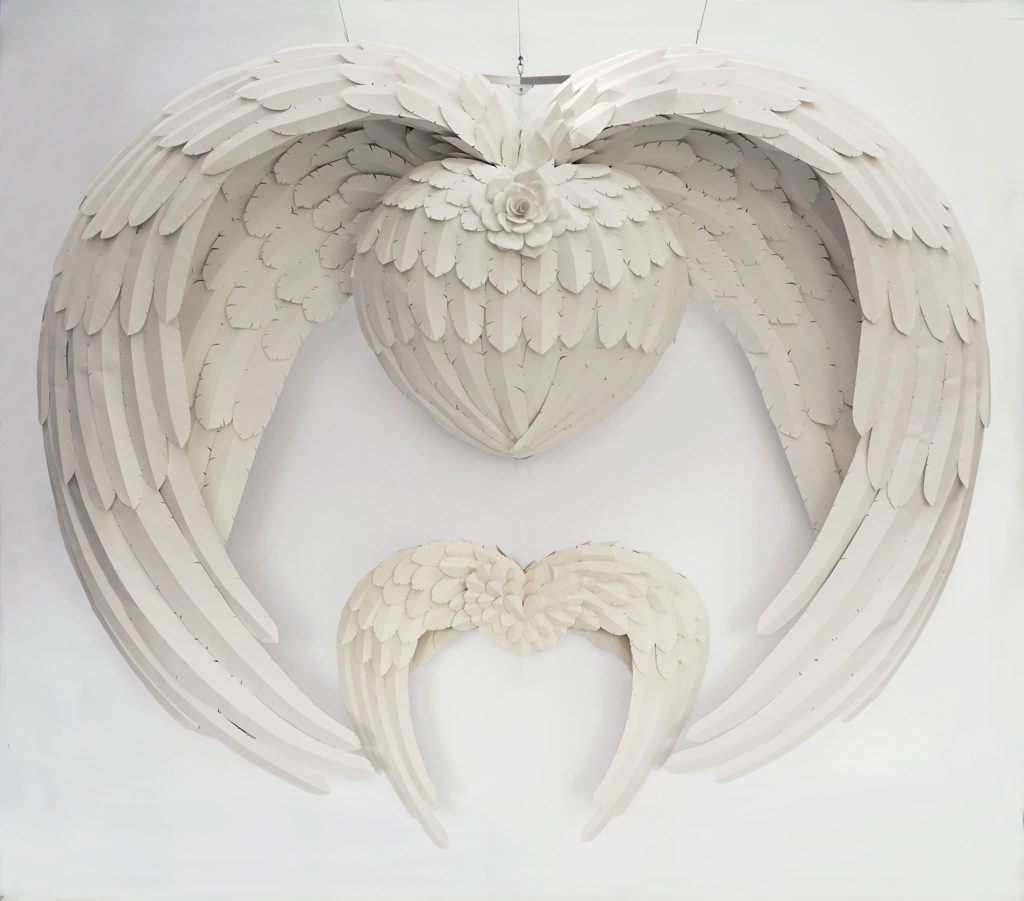
Mother’s Heart
I had three months to design and build a piece that would hang in the centre foyer where mothers could have themselves with children photographed. It is 3.1m high x 3.6m wide and suspends from cables off the rafters. It had to be ready two weeks before Mother’s Day and left little time for sleep! It’s the second largest sculpture I ever built, hugely popular with the public and even brought a request from an art curator in New York to bring it over there!
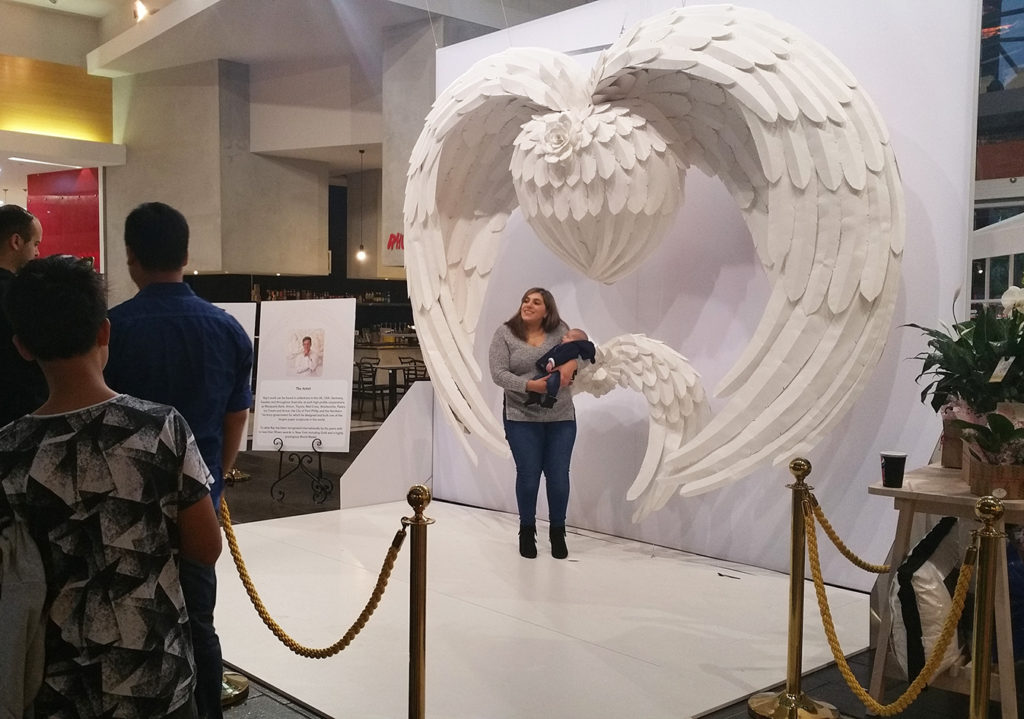 Discuss your thoughts on the importance of children having equipment and the freedom to simply make. How his effected your own artistic growth.
Discuss your thoughts on the importance of children having equipment and the freedom to simply make. How his effected your own artistic growth.
An interesting question Deborah. There is no doubt my past predicted my future, but it might not have done so of it were not for one thing I realised early in life, and that is listen to your heart. It’s your intuition speaking to you, and it’s built on all the things you found joy and purpose in when you were growing up. I believe you must keep the child’s wonder and excitement for life alive in you all your life. My parents gave encouragement to explore my skills and find what interested me through their example and then left me free to proceed my own way. They occasionally intervened to show their ways to draw, or how to mix colours correctly, but mostly they just brought me the raw materials and left me be. The only complaint was the mess I left on and under the table with all the cut paper, but I eventually got around to that!
Explain briefly the technique you use in your art work.
My art is based on forming paper from a flat two-dimensional sheet material into a three-dimensional object. Paper by definition is a flat formed sheet material created by pouring a water suspended mash of organic sourced, cellulosic fibres into a mould and deckle. The material derived from this process is what I use for my art, and I say it that way to keep it distinct from being confused with papier mache or cast paper. It is not quilling, and definitely not paper toll. Picture it this way. If you got a sheet of metal, you could bend, twist and bang and weld it into something that would make a stunning sculpture or even an object like a car. This is how I treat a sheet of paper and create my artworks. There is glue involved where with metal you weld because a sheet of any of these materials only has a limited capacity to being shaped, so you need to add one to another and handle the forming of each piece separately. With my medium I have the freedom to combine a huge variety of different papers to be worked together for added textures and colours, and I source them from all over the world.
What are the different types of paper you use, – how difficult is it to get exciting paper.
My favourite papers are essentially handmade cotton, linen or mulberry fibred papers from small mills around Asia and some of the traditional European Mills. My favourites tend to be Fabriano of Italy, one of Europe’s very oldest and still running, Germany’s Schoellershammer and Hahnemuhle, BKF Rieves and Arches of France and Saunders of the UK. But there are many others based on what interests me when I go scouting through the paper stocks of my favourite handlers. Most of the European papers are cotton based mould-made while those like Awagami from Japan where a vast range of my beautifully delicate mulberry papers come from, are often handmade. The one problem I face is sometimes not buying enough of a particular paper when I see it. I never know what I’m going to use a stock for, so there’s a gamble I may buy and never use something. I have plenty I bought twenty years ago and not touched as testimony, but then as other times happens, I wake up to what I can do with a selection I bought some time ago, get so I excited with it, use it up and curse that I didn’t buy more because I just can’t get it anymore!
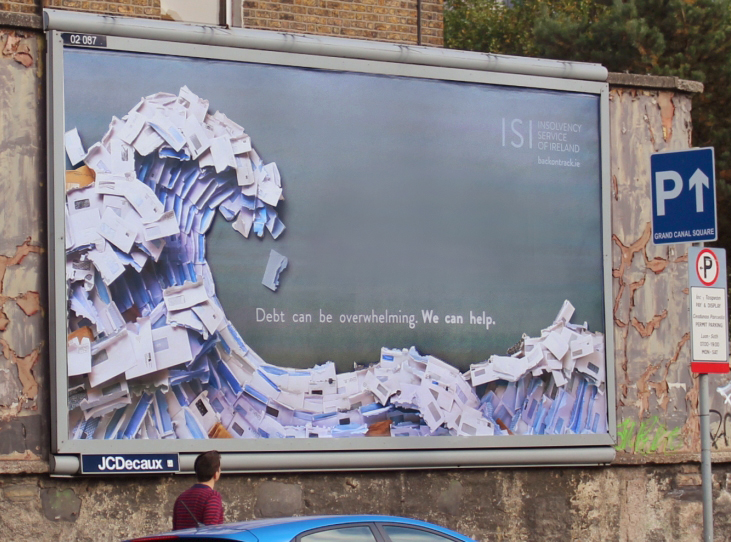
Envelope Wave on 48 sheet poster, Dublin
I don’t often use machine made papers that are based on short cellulose fibres extracted from wood because they have a distinct directional grain and though I will use that to my advantage at times, it’s usually a disadvantage from a sculptural perspective, because they have a polarised plain of strength and weakness. They also have boring textures as a rule.
How do you store your paper and your off cuts?
Ha! You must have an insight into my studio.
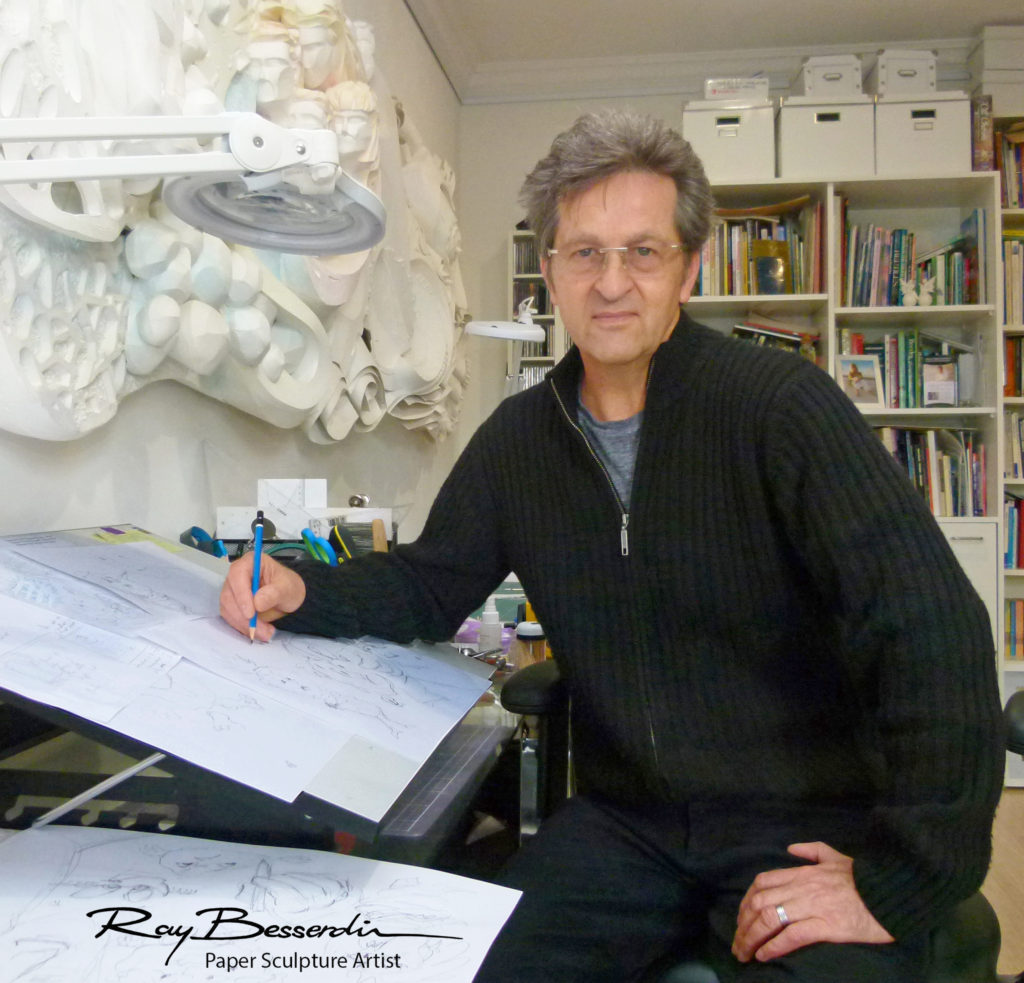
Actually, I wish I had more room because I would store them horizontally where gravity is a little more kind on them, but I designed and had specially built a vertical storage compartment that swings out. It’s very efficient and has vertical dividers that keep the various stock types separated but also prevents the more delicate papers from flopping over and getting kinked. It’s disadvantage is that they can slide down and get damaged, but overall, it works really well.
Discuss the importance of archival paper for the buyer of your work…
Archival papers and materials are critical to my way of art. I want my work to be there for the pleasure of generations to enjoy and I’d hate to think something I did fell apart or changed colour. In fact, I know this will happen with time regardless of how archival my materials are, because it’s in the nature of organic materials to alter with time even in stable temperatures and humidity. But, I want that to be measured in hundreds of years rather than ten or twenty and with the right approach to selecting materials, that’s very doable. And here’s where my undergrad chemistry comes in. I’ve greatly expanded my knowledge on paper and adhesives over the years thanks partly to an industrial chemist who invented the acrylic adhesive I use, the understanding my Uni days chemistry has given me together with further study I still pursue.
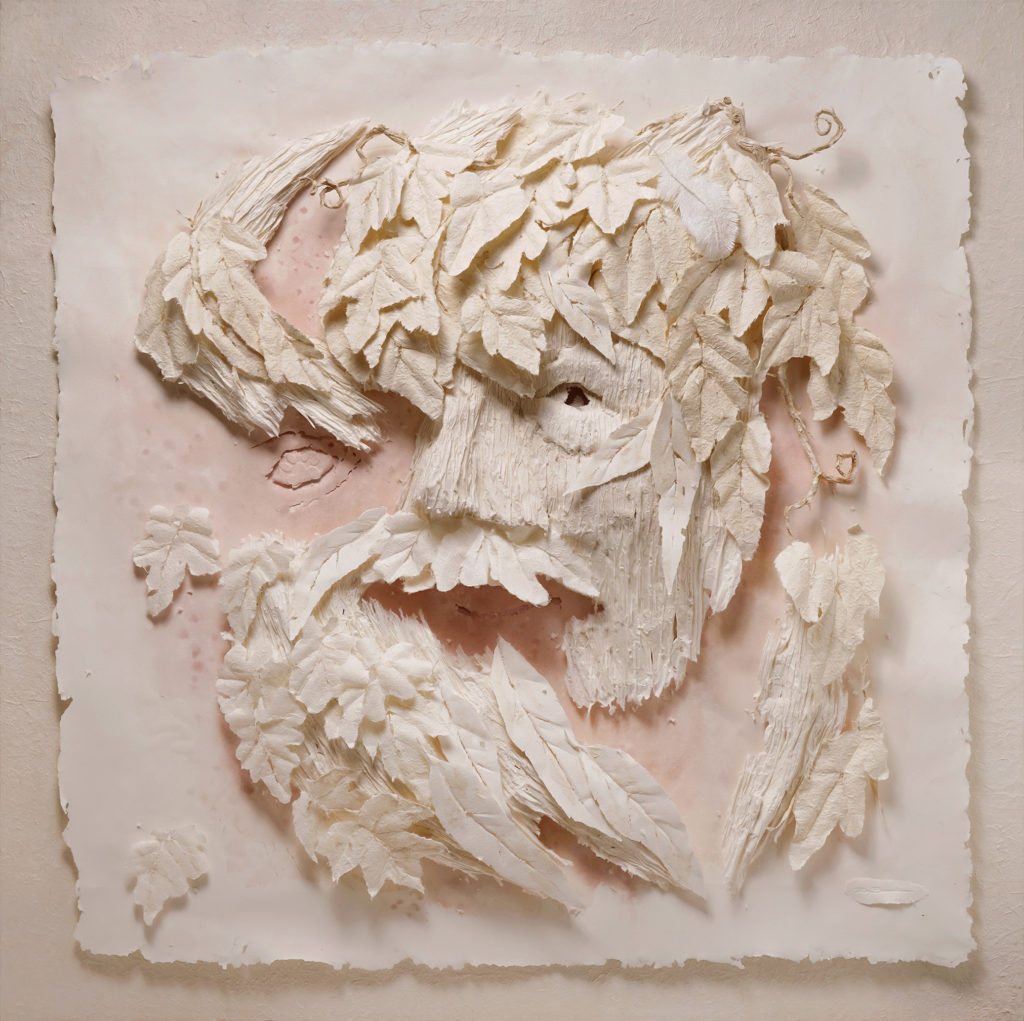
Dionisyan – Green Man, commission piece
All this means that when someone invests in my art, they can rely on it not just for its present-day aesthetics appreciation, but for its long-term increase in value too. An example is Flowing Synthesis which is about as pristine as the day I made it, yet it’s twenty years old and recently valued at about three times what it was commissioned for.
What lead you to leave realism for expressionism and impressionist?
This is a beautiful question Deborah. I will take you back again to my childhood and the difference between my mother and father. I think as I’ve gotten older and become more content with my technical abilities to manipulate my beloved medium of paper, which is my father’s side of me, I have become much more interested in being expressive and not letting the technical dominate my work, which is my mother’s side. At this point in my development I’m now really feeling free to just express myself while confidently in the background knowing I will figure out how to handle the paper so it gives way to a distillation of what I see and feel rather than being bound to technical accuracy and hard edges for example. Funnily enough, in many ways, it’s actually a lot trickier to do because it’s easy to fall back onto comfortable devices like a knife and mechanical folds, but I now strictly limit them. I want the nature of each of these beautiful papers to come out as much as possible and limit myself to basic requirement of first impressions to grasp what I’m portraying. I can’t compare myself to the French “plein air Impressionist painters”, and I don’t mean to but I refer to capturing an impression while not labouring to realistically represent what I see. As for the reference to Expressionism, well I pick one meaning out of that movement of painters in that I really want to raise emotional response from those viewing my art. So, my art, as a someone from the National Gallery once said is like nothing he has ever seen in that it is not the sculpture he knows, and it’s not painting, but something in between. And that leads to my aim to achieve in sculptured paper some measure of what painters do to capture a vision and raise emotion.
It a bigger challenge than doing a realistic representation because you can see the way forward, not so with how you elicit emotional response starting from a sheet of paper.
Discuss the importance of the Wow! factor in your art. Can you explain from the brief to completion you work, ‘Flowing Synthesis Triptych’.
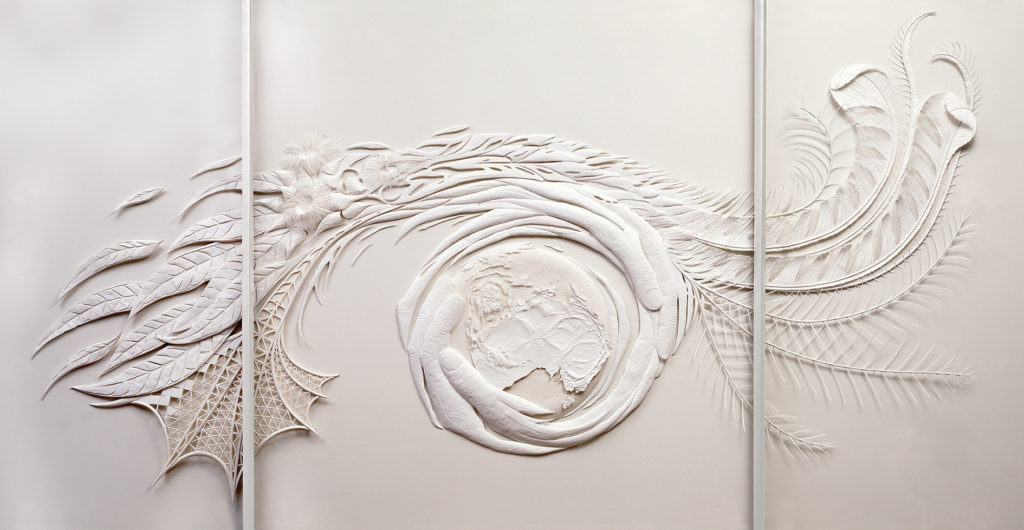
Flowing Synthesis
Flowing Synthesis was the real start to my fine art direction and proved the power of paper sculpture for vision. It began when I started approaching architectural firms to elicit response for an installation. Trouble is, I had never done anything of the type I was trying to talk them into commissioning me for. There was a visionary young lady working in a prominent firm in Collins Street who was designing the refurbishment of the foyer of 150 Lonsdale Street. They had already gone a long way to completing the work. Behind the concierge desk there were three panels that were going to take some sort of slump glass design. The architect said, if you can come up with something better than this and the Macquarie Bank, who owned the building and would purchase the art, approves you’re in. Red rag to a bull! That was the whole brief, so I stewed over it showed them my concept and what came out twelve weeks later won me my first Gold Award in New York, page 4 half page coverage in the Age newspaper and the real beginning of where I am today. The wow factor is something that comes from the beautiful flowing motion expressed over such a large scale of two metres high x three metres long and the simple beauty of the white on white paper. It never ceases to wow those who see it. It regularly brings a tear to people’s eyes because of the emotional response it elicits. It’s actually a synthesis of elements symbolic of Victoria starting with culture in the Arts Centre Spire in the bottom left, Botanical represented by the Mountain Ash leaves and flowers from left across the top to the Faunal symbol given by the Lyrebird tail feathers on the right. I also has an environmental message from my heart to preserve this precious globe we live on represented by the hands caringly encircling the globe, at the centre of which I put Australia, because that’s home. Incidentally, the reason it became a triptych is because of the glass panels it was put behind when it was first installed.
After 15 years in Lonsdale Street, the entrance foyer was remodelled, and the artwork granted back to me at no cost as Macquarie wanted a safe new location to install it but had no immediate solution. I gave it to my wife and it was the feature attraction in my Black Rock Gallery till it was recently closed when our lease expired. I don’t think it will move from our lounge again even when we find a new location closer to town for the new gallery some time in 2019.
You also do 3D work expand on one piece of 3D work that has given you both pleasure to work on and extended your art at the same time.
There is a piece that immediately comes to mind. It’s a huge 3m long work that was spread over about 11 years to finish. I worked on it in spirts, sometimes not revisiting it for months because it was technically incredibly difficult to solve, but it took me to another plain.
It’s called “The Infinite Source”. It’s a philosophical expression of what I believe is the infinite source of all we achieve: The Idea.
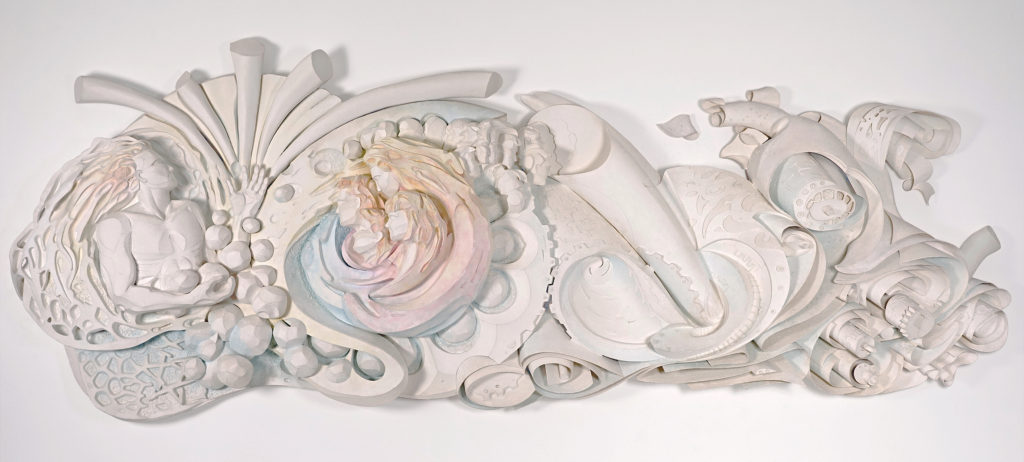
The Infinite Source
The energy of thought beginning like a glowing seed in the man’s head flows through his hands with amorphous masses being matter that we transform into everything and anything, and springs upward like an endless fountain. Symbolically of perfection, I created the man to look like a Greek God.
I put woman with nurtured family in the middle of a driving cog and coloured them to emphasis my belief that they are the centre of our existence. The faces-within-faces form is a reference to extended relationships with others including friends and colleagues, all of whom we depend on too, because we are social beings and do not do things alone.
The big cog drives all we create, in this case expressed in a paper industry, shown with swirling sheets of the material, references to electric motors, cutting mechanisms and other machinery. There are also references to digital intelligence with numbers and symbols spread throughout. It winds and twirls off in all directions into infinity.
It’s the only piece apart from the NT mega sculptures and Mother’s Heart that is not behind glazing. It’s an example of the impressive durability and strength of paper as a sculptural art medium and was a hugely complex task to solve for its shapes, forms and depth. Created in Australian Blue Lake Paper Mill, handmade 100% cotton rag papers weighing 1000gsm, it is surface sized and requires only regular dusting to keep clean.
Take a very small piece and discuss the work.
I’m not really big into small, pardon my play on words! Mainly because I love to be wowed by artwork, and somehow things become surreal when they’re really in your face. However, there are some very small things I’ve done for example like four children’s books I was commissioned to do by Hameray Publishing in Los Angeles. They tell of the Aesop’s Fables and they were a chance to again reflect on my mother I suspect.
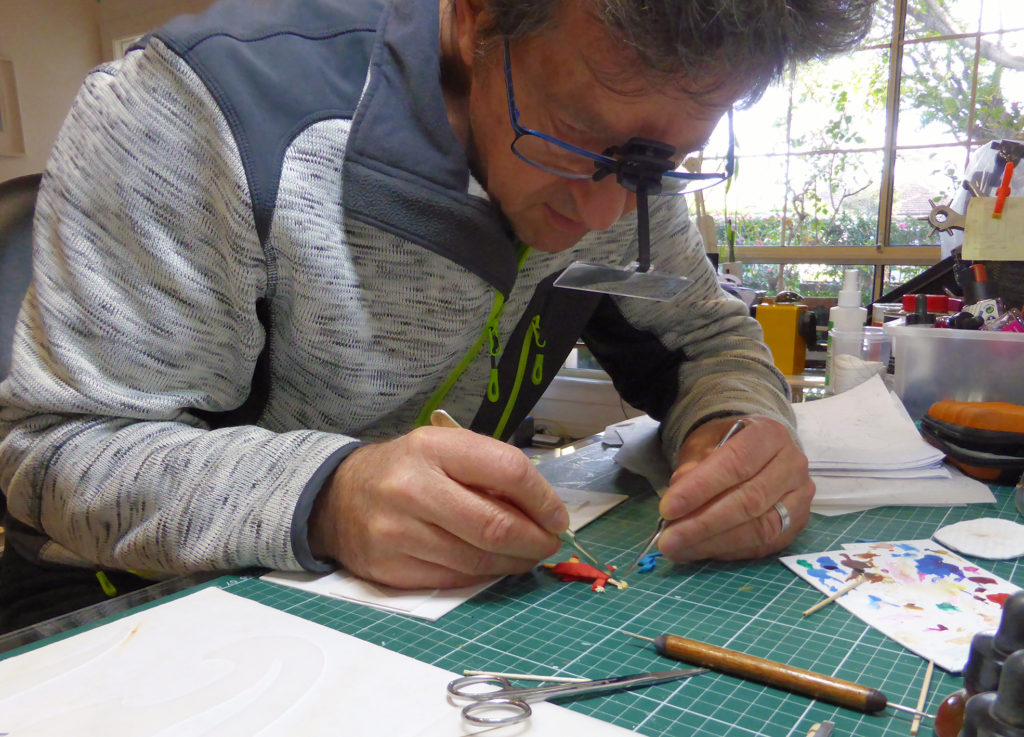
Aesop’s Fables (in progress)
She was a great cartoonist and I always loved caricature, which these illustrations are based on. These books were a load of fun but really tested my eyes as there were times I had to work with magnifiers on my glasses to cut the tiny pieces like mouth parts, eyes and hands!! There’s a video of making these books on my website. Gratifyingly, they are the publisher’s best sellers in this category because the kids love the colour and dimensional reproduction of the illustrations. They are all originally a 3D paper sculpture that I photograph for reproduction in print.
On that topic, I also created a separate brand to exercise another lifelong love of caricature, something that was obvious in high school where I was one of the regular school magazine cartoonists. I trademarked in 26 countries these paper sculpture characters I called the Paperartzi® and printed them here in Australia on really colourful, premium quality greeting cards, environmentally responsible techniques of course. They have quite a strong following because they’re very different and make people happy. The idea sprung from seeing all these bits of paper on my studio floor, and I wondered what would happen if they came to life. So, I put faces on them, called them Rip-Torns and then went further and decided I should create a world of all objects paper coming to life and called them all the Paperartzi® I keep them separate from my fine art because it confuses branding but you can find the website or the Instagram page and see them all! And yes, they’re quite small at an average of around 100mm or less.
Making North Wind and Sun
Take on of your largest piece and expand on the technical difficulties you in counter due to size.
Well, this was a massive challenge because my works had never been so big, and they also had to faced exposure to the outdoors for a short time. What if it rained? What if it was really windy? When I accepted the challenge to create the NT mega paper sculptures I also had to figure out how to build them in my work shop, a converted basic single car garage where a car has never been parked. These sculptures would be too big to fit in one piece.
I got talking to one of my favourite paper mills, unfortunately not operating any longer, based in Mt Gambier. Kelvin the owner of Blue Lake Paper Mills made special sheets like never before, at 2.4 by 1.2 metres and weighing 1000gsm in pure cotton rag, sized both externally and internally to resist water. Geoff, my industrial chemist friend made about 40 litres of his super acrylic adhesive and I then figured out how to make the whole construction of each sculpture with such integrity, they are like the monocoque build of a modern car. Very strong.
The solution to the workshop restrictions was to make them in pieces and in fact I never saw them completed until they were assembled in situ. To my relief they fitted together perfectly and from design to delivery it was all done in just six months! The public was wowed, and the client thrilled. To my knowledge, they wound up in the Alice Springs Airport but I’m not sure if they’re still there.
Can you explain ‘Endeavour’s Hands’.
It’s an image expression of how I see our pathway in life.

Endeavour’s Hands
I love the expressive capability of hands and use them to show the similarity between the challenges of our endeavours with those of a flowing river. Life is not a smooth, straight path. We’re faced with continual learning and decision making, turning us this way then that way; reaching for the help of others or in turn offering them ours, yet always reaching forward.
Water flows with seemingly unimportant impact yet can cut its way through mountains. The visual metaphor of strength and determination of something so fluid as a river inevitably meandering toward and reaching its destination, overcoming its obstacles offers both poignant example and parable to remember.
Water here is represented by the delicate, mere 8gsm Japanese handmade, translucent tissue. The hands are of French, BKF Rieves 300gsm (NOT) cotton paper.
Dimensions: 160 cm H x 80cm W x 9cm D
The Award you won
Mornington Peninsula and Regional Gallery hold what they regard is the pinnacle of biannual exhibitions of works on paper, called the National Works on Paper, or NWOP. That means any kind of art including print making, photography and digital printing, painting and dimensional work.
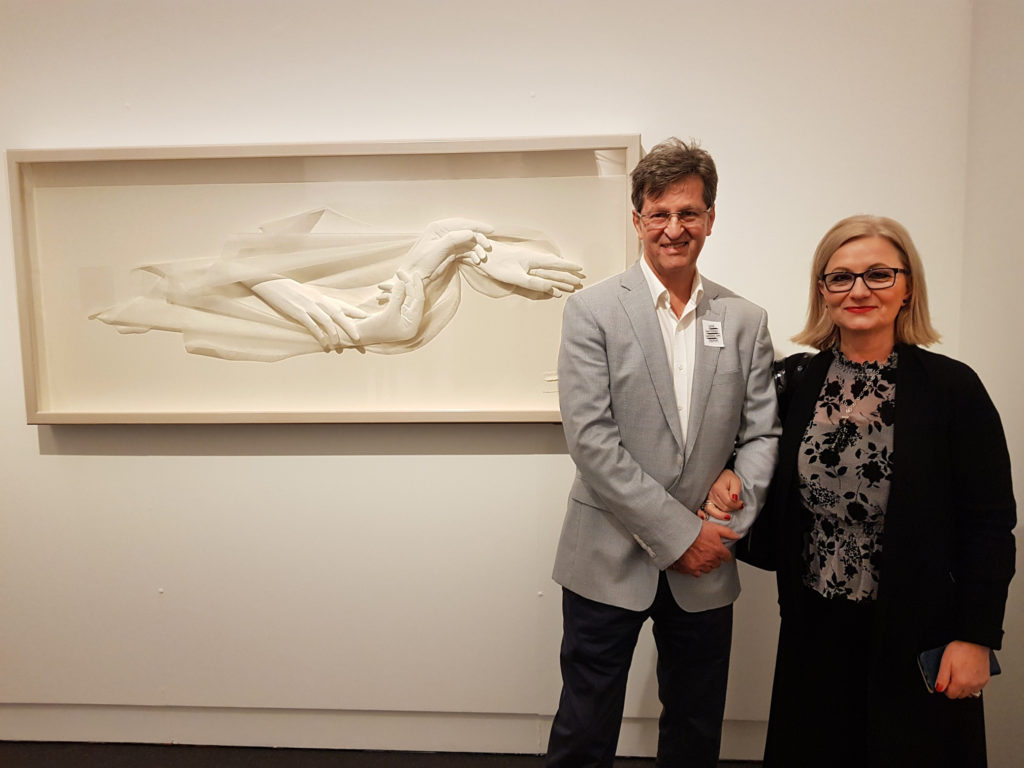
At National Works on Paper
Of the thousands of visitors to the exhibition that went from two months from July this year, the opportunity was there to vote for their favourite artwork. My paper sculpture entry had people intrigued going on the responses at the opening. No one had seen anything like it but winning the People’s Choice Award at NWOP, which came with a financial reward to boot was so satisfying because I was delighted by how it affected the public.
The importance of placing your work into art competitions.

Australian Native Flowers
I love competitions for a couple of reasons. Firstly, they are a terrific chance to get my work out into public view, but the sort of public who love art. You also get valuable social proof that helps others have confidence to invest in your art and it fullfils an ambition of mine, which is to take to the public my love of paper, a medium so beautiful and enduring it deserves to be shown for what can be done with it.
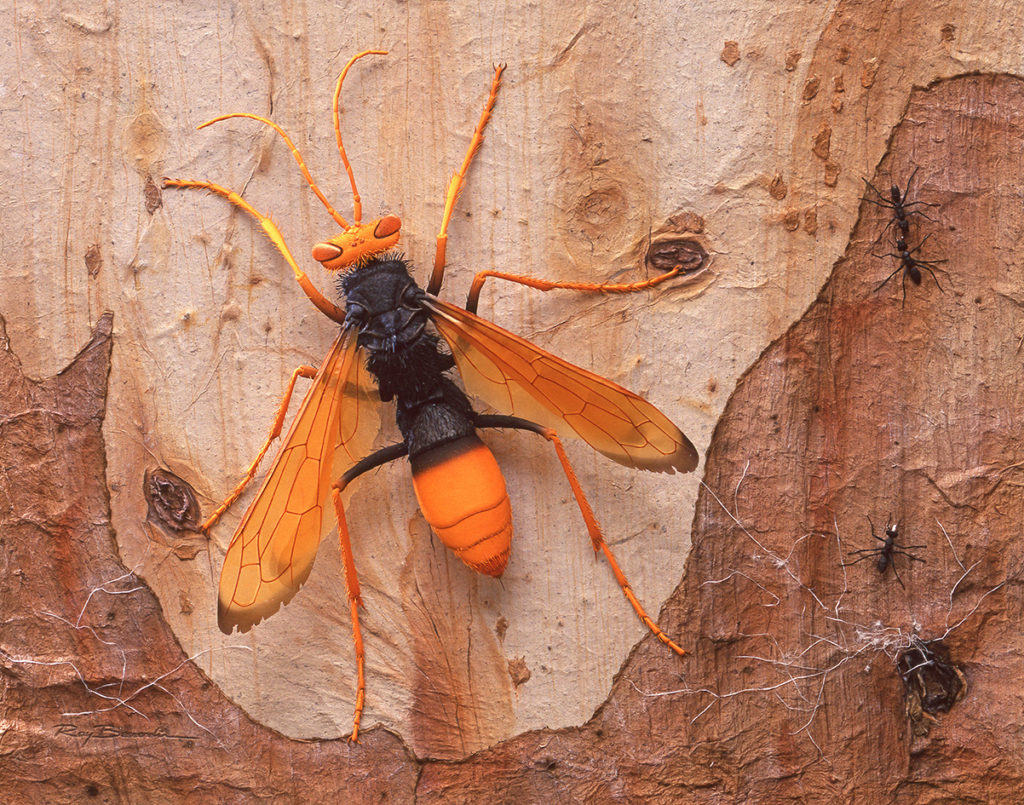
Spider Hunter Wasp on bark: 100% sculptured paper
Just a little thing I want to add here and then I’ll finish. Over nearly 29 years I have managed to achieve so much with what started out as a little design for an ad campaign, and one thing just led to another. It makes me very proud to look back and see how I’ve progressed but it’s been through having vision and following my heart. It’s also been through courage, hard work and doing what I thought was right regardless of what was mostly understood, like painting and other traditional art mediums. I think art is about pushing boundaries, not just what you say about cultural matters for example, but also what you show can be done to express your ideas by means others hadn’t. And doing what I do with paper is creating just that sort of interest because it hasn’t been seen. Though I recently closed the Black Rock gallery, I will be relocating it in time. It was the only gallery of its kind in Australia and that was another very proud achievement that has given a great deal of pleasure to a great many public.

Black Rock gallery
I’ll finish with this, it’s my mission: To create works of art from sheet formed papers that will ever push the artistic expression, technical bounds and appreciation of this ancient, durable, incredibly diverse and stunningly beautiful medium.
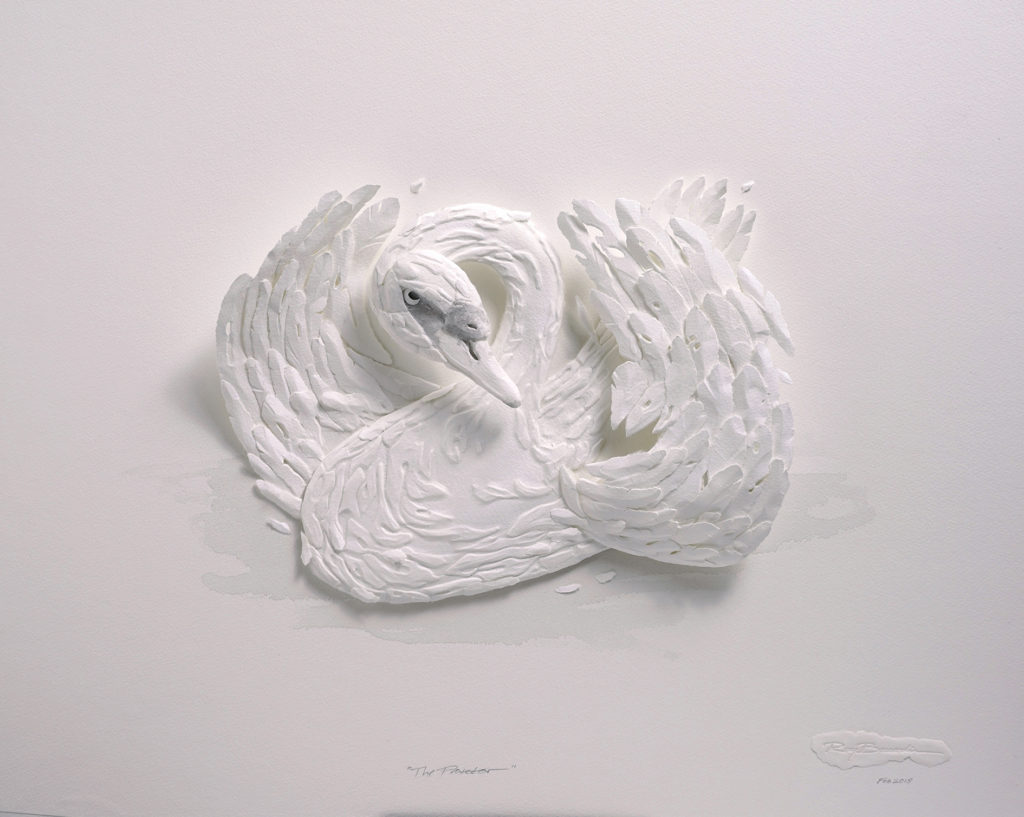
The Swan the Protector
Contact details:
Ray Besserdin
Also
Ray Besserdin, Melbourne, Australia
Interview by Deborah Blakeley, October 2018
Think a colleague or friend could benefit from this interview?
Knowledge is one of the biggest assets in any business. So why not forward this on to your friends and colleagues so they too can start taking advantage of the insightful information the artist has given?
Other artists you may be interested in:






